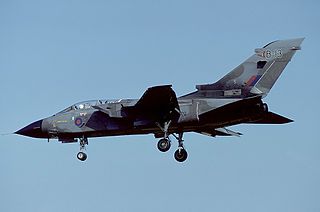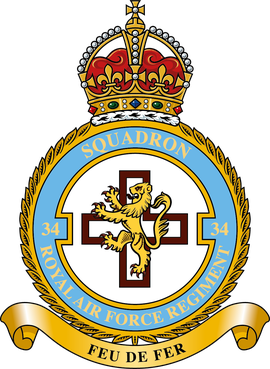
The Army Air Corps (AAC) is the aviation arm of the British Army, first formed in 1942 during the Second World War by grouping the various airborne units of the British Army. Today, there are eight regiments of the AAC, as well as two independent flights and two independent squadrons deployed in support of British Army operations around the world. Regiments and flights are located in the United Kingdom, Kenya, and Canada. Some AAC squadrons provide the air assault elements of 16 Air Assault Brigade, through Joint Helicopter Command.

Royal Air Force Cottesmore or more simply RAF Cottesmore is a former Royal Air Force station in Rutland, England, situated between Cottesmore and Market Overton. On 15 December 2009, Defence Secretary Bob Ainsworth announced that the station would close in 2013 as part of defence spending cuts, along with the retirement of the Harrier GR9 and the disbandment of Joint Force Harrier. The formal closing ceremony took place on 31 March 2011, and the airfield became a satellite of RAF Wittering until March 2012.

Joint Helicopter Command Flying Station Aldergrove, also known as simply JHC FS Aldergrove, is a British military base located 4.4 miles (7.1 km) south of Antrim, Northern Ireland and 18 miles (29 km) northwest of Belfast, and adjoins Belfast International Airport. It is sometimes referred to simply as Aldergrove which is the name of a nearby hamlet.

The Royal Air Force Regiment is part of the Royal Air Force and functions as a specialist corps. Founded by Royal Warrant in 1942, the Corps carries out soldiering tasks relating to the delivery of air power. Examples of such tasks are non-combatant evacuation operation (NEO), recovery of downed aircrew, and in-depth defence of airfields by way of aggressively patrolling and actively seeking out infiltrators in a large area surrounding airfields. In addition the RAF Regiment provides Joint Terminal Attack Controllers (JTACs) to the British Army in the Tactical Air Control Party (TACP) role, and provides flight size commitment to the Special Forces Support Group.
Options for Change was a restructuring of the British Armed Forces in summer 1990 after the end of the Cold War.

No. 20 Squadron is the Royal Air Force's Operational Conversion Unit (OCU) for ground-based Tactical Air Command and Control, and Air Battle Management. It is part of the RAF's Air Surveillance and Control System (ASACS) and is based at RAF Boulmer. It was allocated the role on 1 June 2021.

No. 1 Squadron RAF Regiment is a field squadron of the RAF Regiment in the Royal Air Force. Its mission is protection of RAF bases from ground attack, and patrolling a large area around main operating bases abroad, in order to defend aircraft on ingress and egress from surface to air attack. It is currently based at RAF Honington.

No. 51 Squadron RAF Regiment is a field squadron of the RAF Regiment in the Royal Air Force. Its mission is protection of RAF bases from ground attack.

The Royal Auxiliary Air Force (RAuxAF), formerly the Auxiliary Air Force (AAF), together with the Air Force Reserve, is a component of His Majesty's Reserve Air Forces. It provides a primary reinforcement capability for the regular service, and consists of paid volunteers who give up some of their weekends, evenings and holidays to train at one of a number of squadrons around the United Kingdom. Its current mission is to provide trained personnel in support of the regular RAF.

The II Squadron RAF Regiment is a Field Squadron of the RAF Regiment based at RAF Brize Norton. Some of its gunners receive parachute training.

No. 15 Squadron RAF Regiment is a field squadron of the RAF Regiment in the Royal Air Force. Its mission is protection of RAF bases from ground attack. The squadron's headquarters is at RAF Marham, having moved from RAF Honington.

No. 34 Squadron RAF Regiment is a C-UAS Sqn of the RAF Regiment in the Royal Air Force. Its mission is to detect, track, and ultimately disrupt and destroy unmanned airborne vehicles. The squadron's current HQ is at RAF Leeming. The motto of the squadron is "Feu de Fer "(Fire from Iron).
The Number 2 Armoured Car Company RAF was a military unit of the British Royal Air Force (RAF) which was based at Amman in what was then called the Transjordan. It was the counterpart of No.1 Armoured Car Company RAF, which performed a similar role in Iraq.
No. 679 Squadron AAC is a British Army Reserve helicopter support squadron and is part of the 6 Regiment Army Air Corps. The squadron provides groundcrews to support Apache AH1 helicopters.
No. 660 Squadron AAC is a squadron of the British Army's Army Air Corps (AAC). The squadron traces its lineage to a Royal Air Force squadron that existed during the Second World War. In the late 1950s the squadron's numerical was transferred to the AAC and since its formation in 1969, it has operated as a British Army unit flying various types of battlefield helicopters. The squadron has been re-formed and disbanded on a number of occasions. The squadron is currently based at RAF Shawbury where it forms part of No. 1 Flying Training School, but it has been deployed operationally to Northern Ireland, Hong Kong and Brunei throughout its existence.
5 Regiment Army Air Corps is a regiment of the British Army and is part of the Joint Helicopter Command (JHC). The regiment is based in Northern Ireland at JHC Flying Station Aldergrove.
This is the order of battle for Operation Granby, the name given to the British Armed Forces deployment to the Middle East after the Iraqi invasion of Kuwait on 2 August 1990 and subsequent operations during the 1991 Gulf War.
The following is a hierarchical outline for the structure of the British Army in 1989. The most authoritative source for this type of information available is Ministry of Defence, Master Order of Battle, and United Kingdom Land Forces, HQ UKLF, UKLF ORBAT Review Action Plan, HQ UKLF, 1990.
No. 37 Squadron RAF Regiment was a Ground Based Aircraft Defence (GBAD) squadron of the Royal Air Force Regiment. The squadron operated mostly outside the United Kingdom since its formation in 1951 until 2006 when it was disbanded. It started out as a field squadron before becoming involved in the GBAD programme, where it operated the Rapier missile system.











